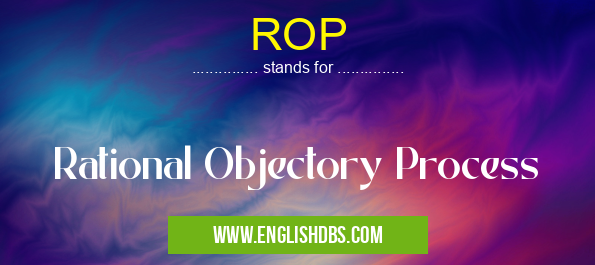What does ROP mean in COMPUTING
ROP aims to provide a structured approach for software development, emphasizing collaboration, traceability, and continuous improvement. It follows an iterative approach, where requirements are progressively refined and implemented through multiple iterations. The process incorporates best practices from object-oriented design, such as encapsulation, inheritance, and polymorphism.

ROP meaning in Computing in Computing
ROP mostly used in an acronym Computing in Category Computing that means Rational Objectory Process
Shorthand: ROP,
Full Form: Rational Objectory Process
For more information of "Rational Objectory Process", see the section below.
Rational Objectory Process (ROP)
ROP stands for Rational Objectory Process, a software development methodology designed to enhance the quality and efficiency of software development. Developed by Rational Software, this iterative and incremental process combines object-oriented modeling, design, and implementation practices.
Key Features
- Iterative and Incremental Development: ROP breaks down development into smaller, manageable iterations, allowing for early feedback and course corrections.
- Object-Oriented Approach: It embraces object-oriented principles to organize code and data into reusable entities, promoting maintainability and extensibility.
- Use Case-Driven: ROP revolves around identifying and defining use cases, which represent the intended functionality of the software system.
- Model-Based Development: It utilizes Unified Modeling Language (UML) diagrams to document and represent system requirements, design, and implementation.
- Continuous Improvement: ROP incorporates mechanisms for continuous feedback and improvement, enabling teams to learn from their experiences and adapt the process accordingly.
Benefits
- Improved software quality through rigorous modeling and iterative development.
- Reduced development time and cost due to the incremental approach and object-oriented reuse.
- Enhanced collaboration among development teams through clear documentation and traceability.
- Increased adaptability to changing requirements due to the iterative nature of the process.
- Better risk management by identifying and mitigating potential issues early in the development cycle.
Essential Questions and Answers on Rational Objectory Process in "COMPUTING»COMPUTING"
What is Rational Objectory Process (ROP)?
Rational Objectory Process (ROP) is a software development methodology that combines the principles of object-oriented design and the Rational Unified Process (RUP). It provides a structured approach to developing software systems that are maintainable, extensible, and reusable.
What are the benefits of using ROP?
ROP offers several benefits, including:
- Improved software quality and reliability
- Increased productivity and efficiency
- Reduced development time and costs
- Enhanced communication and collaboration among stakeholders
What are the key components of ROP?
The key components of ROP include:
- Object-oriented analysis and design
- Use-case modeling
- Iterative and incremental development
- Test-driven development
- Configuration management
How is ROP different from other software development methodologies?
ROP differs from other methodologies in the following ways:
- It emphasizes object-oriented principles throughout the development process.
- It incorporates use-case modeling to capture the functional requirements of the system.
- It uses an iterative and incremental approach to development, allowing for early feedback and adjustments.
- It places a strong emphasis on testing and quality assurance.
What tools are available to support ROP development?
Various tools can support ROP development, including:
- Rational Rose for visual modeling
- Rational ClearQuest for defect tracking
- Rational Team Concert for collaboration and version control
- JUnit for unit testing
Is ROP suitable for all types of software development projects?
ROP is particularly well-suited for complex, object-oriented software projects that require a high level of maintainability, extensibility, and reusability. However, it can be adapted to smaller projects as well.
Final Words: ROP provides a comprehensive methodology for software development that fosters collaboration, improves quality, and promotes continuous improvement. Its iterative and object-oriented approach enables teams to deliver high-quality software solutions efficiently. By embracing ROP principles, organizations can enhance their software development processes, resulting in improved productivity, reduced costs, and increased customer satisfaction.
ROP also stands for: |
|
| All stands for ROP |
